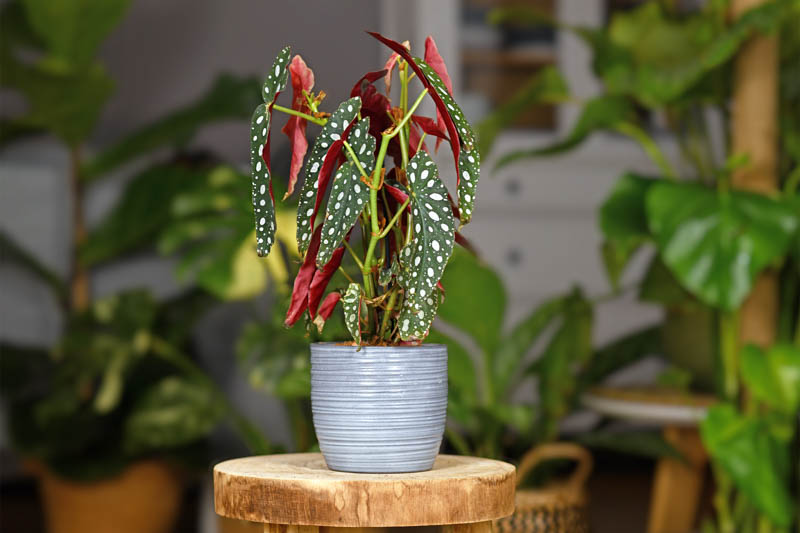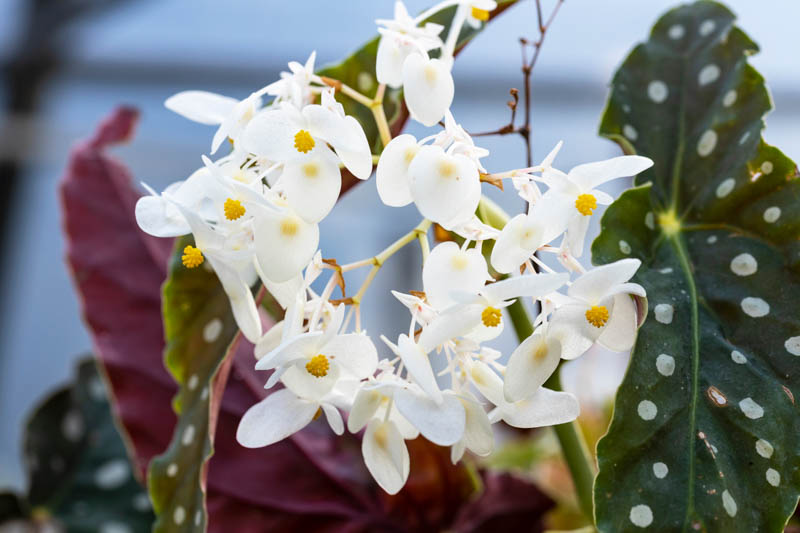Polka Dot Begonia, Spotted Begonia, Trout Begonia, Angel Wing Begonia, Clown Begonia, Begonia argyrostigma
Begonia maculata, commonly known as the Polka Dot Begonia, is a visually striking houseplant that is renowned for its unique appearance and ease of care. It offers a stunning aesthetic with its distinctively spotted leaves and showy blooms.
Begonia maculata features large, angel-wing-shaped leaves that are dark green and adorned with bright, silvery spots, giving it the “polka dot” nickname. The undersides of the leaves are a rich red, adding to the plant’s dramatic flair.
Native: This species is native to the tropical rainforests of Brazil, where it grows in a humid environment under the canopy of the forest, receiving filtered light. It belongs to the begonia family (Begoniaceae), which includes over 1,800 species and thousands of hybrids.
Plant Type and Habit: Begonia maculata is a fibrous-rooted species that exhibits an upright, bushy growth habit with a somewhat cascading form when the stems become longer and heavier.
Size: The plant typically reaches 24-36 inches (60-90 cm) in height and can spread approximately 12-18 inches (30-45 cm) wide. Its size makes it ideal for indoor cultivation as a decorative houseplant.
Flowers: Begonia maculata produces clusters of delicate, white to pale pink flowers that dangle elegantly from pinkish-red stems. The blooms add an extra layer of ornamental value to the plant. The flowering season generally spans from spring through fall, with peak blooming often occurring in the warmer months.
Foliage: The foliage is the most striking feature, with angelic leaves up to 8 inches (20 cm) long, spotted with symmetrical silvery-white dots that contrast dramatically against the dark green leaf surface.
Hardiness: As a tropical plant, Begonia maculata is not frost-tolerant and is hardy in USDA zones 10-12 if grown outdoors. It is primarily cultivated as an indoor plant in most climates.
Uses: Begonia maculata is primarily used as an ornamental indoor plant. It is popular in homes and offices for its decorative leaves and is often used in interior landscaping and container gardens.
Toxicity: Begonia maculata is known to be toxic to pets if ingested, causing irritation and potentially more severe digestive upset.
Invasiveness: Begonia maculata is not considered invasive. It is primarily grown as a controlled indoor plant and lacks the mechanisms to spread aggressively in natural environments.
Benefits: Begonia maculata is not considered invasive. It is primarily grown as a controlled indoor plant and lacks the mechanisms to spread aggressively in natural environments.

Light: Polka Dot Begonia thrives in bright, indirect light. Inadequate light may cause the plant to become leggy and lose the intensity of its leaf markings.
Soil: Use a light, well-draining potting mix. A mixture suitable for African violets, which typically contains peat moss, perlite, and vermiculite, works well for maintaining the slightly acidic conditions that begonias prefer.
Watering: Water your Polka Dot Begonia when the top inch of soil feels dry. Avoid letting the plant sit in water, and be careful not to overwater, as begonias are prone to root rot.
Humidity: This plant prefers higher humidity levels, similar to its native tropical environment. Maintaining a humidity level around 50% or higher will keep your begonia healthy. Use a humidity tray or a room humidifier to achieve these conditions, especially during dry winter months.
Temperature: Ideal temperatures for this begonia are between 65°F and 75°F (18°C to 24°C). Avoid exposure to temperatures below 60°F (15°C), as cold drafts can damage the plant.
Fertilizing: During the growing season (spring through summer), fertilize the plant every two to three weeks with a half-strength balanced liquid fertilizer. Reduce feeding in the fall and winter when the plant’s growth naturally slows.
Pruning: Regularly remove any dead or dying leaves to keep the plant healthy and prevent disease. You can also prune the begonia to shape it or control its size. This is best done in the spring.
Cleaning: Wipe the leaves occasionally with a damp cloth to remove dust and help the plant breathe and photosynthesize efficiently.
Repotting: If repotting, choose a pot that is only slightly larger than the previous one, as begonias can struggle in overly large containers.

Propagating a Polka Dot Begonia is a rewarding way to expand your collection or share this stunning plant with friends and family. This begonia can be easily propagated through stem cuttings.
Select and Cut a Stem: Choose a healthy, vigorous stem with at least 2-3 leaf nodes. The best time to take cuttings is during the spring or early summer when the plant is actively growing. Using clean, sharp scissors or pruning shears, cut just below a node. The cutting should be about 4-6 inches long.
Prepare the Cutting: Remove the leaves from the lower half of the cutting to expose the nodes. This is where the roots will form.
Rooting the Cutting: You can root the cutting in water or directly in soil:
Water: Place the cutting in a jar of water, ensuring no leaves are submerged. Change the water every few days to keep it fresh. Roots should appear in a few weeks.
Soil: Dip the cut end into rooting hormone (optional) and plant it in a pot filled with a well-draining potting mix. Water it well and cover the pot with a plastic bag to create a humid environment, which helps with root development.
Care for the Cutting: Place the pot or jar in indirect light and avoid direct sunlight, which can scorch the young cutting. If planted in soil, keep the soil consistently moist but not soggy. Remove the plastic bag periodically to let fresh air in and prevent mold growth.

Polka Dot Begonia is relatively easy to care for but, like all plants, can be susceptible to certain pests, diseases, and common cultural problems. Identifying these issues early and managing them effectively can help ensure your plant remains healthy and attractive. Here’s what to watch out for:
Mealybugs: These pests appear as small, white, cottony masses on the plant. Like aphids, they suck sap and weaken the plant, and also excrete honeydew.
Spider mites: These tiny arachnids are barely visible to the naked eye but can cause significant damage. They suck sap from the leaves, leading to stippled, discolored foliage and overall plant stress. Spider mites thrive in dry conditions.
Aphids: Small, soft-bodied insects that cluster on new growth and the undersides of leaves, aphids can weaken the plant by sucking sap and excreting sticky honeydew.
If you detect pests, isolate the affected plant to prevent the spread to other houseplants. A strong jet of water can dislodge many pests, especially aphids and spider mites. Insecticidal soap or neem oil are effective against most common pests and are safe for use on the Polka Dot Begonia. Apply according to label instructions, ensuring thorough coverage, especially under the leaves.
Root rot: This is typically caused by overwatering and poor drainage. Root rot can be fatal if not addressed quickly.
Leaf spot: Fungal or bacterial leaf spots can appear if the leaves are kept too wet or if the plant is in an overly humid environment without sufficient air circulation.
Ensure the plant is in well-draining soil and that containers have drainage holes. Water only when the top inch of the soil feels dry. If leaf spots occur, reduce leaf wetness, improve air circulation, and consider applying a fungicide if the problem persists.
Leaf Spot and Scorch: Direct sunlight can cause scorch marks on leaves, while water left on foliage can lead to sunburn spots.
Legginess: Insufficient light may cause the plant to stretch toward the light source, resulting in sparse, elongated growth.
| Hardiness |
10 - 12 |
|---|---|
| Plant Type | Houseplants, Perennials |
| Plant Family | Begoniaceae |
| Genus | Begonia |
| Exposure | Partial Sun |
| Season of Interest |
Spring (Early, Mid, Late) Summer (Early, Mid, Late) Fall Winter |
| Height |
2' - 3' (60cm - 90cm) |
| Spread |
1' - 2' (30cm - 60cm) |
| Spacing |
12" - 18" (30cm - 50cm) |
| Maintenance | Low |
| Water Needs | Average |
| Soil Type | Clay, Loam, Sand |
| Soil pH | Acid, Neutral |
| Soil Drainage | Moist but Well-Drained, Well-Drained |
| Characteristics | Showy, Evergreen |
| Garden Uses | Patio And Containers |
| Hardiness |
10 - 12 |
|---|---|
| Plant Type | Houseplants, Perennials |
| Plant Family | Begoniaceae |
| Genus | Begonia |
| Exposure | Partial Sun |
| Season of Interest |
Spring (Early, Mid, Late) Summer (Early, Mid, Late) Fall Winter |
| Height |
2' - 3' (60cm - 90cm) |
| Spread |
1' - 2' (30cm - 60cm) |
| Spacing |
12" - 18" (30cm - 50cm) |
| Maintenance | Low |
| Water Needs | Average |
| Soil Type | Clay, Loam, Sand |
| Soil pH | Acid, Neutral |
| Soil Drainage | Moist but Well-Drained, Well-Drained |
| Characteristics | Showy, Evergreen |
| Garden Uses | Patio And Containers |
How many Begonia maculata (Polka Dot Begonia) do I need for my garden?
| Plant | Quantity | |
|---|---|---|
| Begonia maculata (Polka Dot Begonia) | N/A | Buy Plants |
Create a membership account to save your garden designs and to view them on any device.
Becoming a contributing member of Gardenia is easy and can be done in just a few minutes. If you provide us with your name, email address and the payment of a modest $25 annual membership fee, you will become a full member, enabling you to design and save up to 25 of your garden design ideas.
Join now and start creating your dream garden!
Create a membership account to save your garden designs and to view them on any device.
Becoming a contributing member of Gardenia is easy and can be done in just a few minutes. If you provide us with your name, email address and the payment of a modest $25 annual membership fee, you will become a full member, enabling you to design and save up to 25 of your garden design ideas.
Join now and start creating your dream garden!